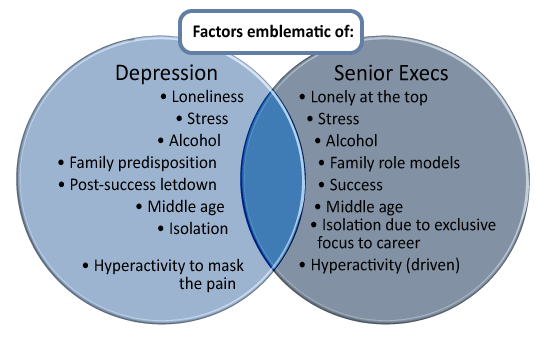Amongst executive ranks, mental health issues are a tribal taboo. That does not mean they do not exist. The “taboo” aspect feeds the problem because it discourages colleagues from taking action, such as having a candid conversation with the person who is suffering. This is not only the caring thing to do, it is the prudent thing to do from a business point of view — depression impacts a person’s ability to be productive (or even present), and the morale of those in proximity.
According to the National Institute of Mental Health (NIMH), each year 6.7% of US adults will experience major depressive disorder. According to a Psychology Today article entitled The Depressed Exec, some believe that the incidence among executives is even higher.
The Venn diagram depicts only a select subset of factors underlying depression and a select set of aspects related to being a CEO or other senior executive, but the point is hard to miss: there is overlap between what leads to depression and what either leads to or coexists with reaching top executive ranks. Because of this overlap and because of our own experience having dealt with several executives over the years who appeared to be depressed, we are inclined to agree that the incidence among senior executives might be a bit higher. To best serve these clients, we suggested treatment with a mental health professional. Coaching is not an appropriate response to depression, although it can work well in concert with counseling.
Depression in the workplace tends to be a deep, dark secret, particularly at the top. Executives do not want to risk appearing out of control or jeopardizing their jobs, and the people around them do not want to mention that the emperor has no clothes. The stigma and code of silence about depression — or any other mental health disorder — is alive and well in the C-suite.
Depression is treatable . . . but only for someone who seeks treatment. If you are concerned about a colleague, direct report, or a leader who might be suffering from depression, other emotional distress, or substance abuse, take responsibility for helping that person get help. Don’t be too scared to care. The best thing to do, as in any potentially conflictual situation, is talk to the person who is the object of your concern. Or you could go to an ombudsman, if your organization provides that service — an ombudsman is bound by professional ethics to treat such concerns confidentially.
From a practical point of view, depression affects the performance and sometimes the physical presence of executives, which in turn, affects everyone around them — and it ultimately affects the business. The costs of depression are significant. The National Alliance on Mental Illness (NAMI) discusses The Impact and Cost of Mental Illness: The Case of Depression in its Policymakers Toolkit. The motivation to help may be compassion but the benefits of helping will likely be both human and economic.
Is there someone in your workplace that you suspect is suffering from depression? How can you help that person seek appropriate help?









